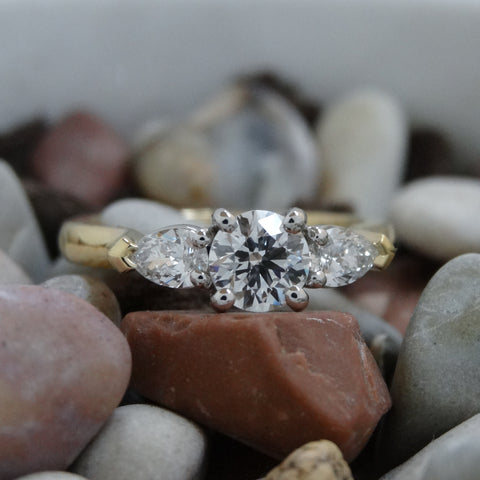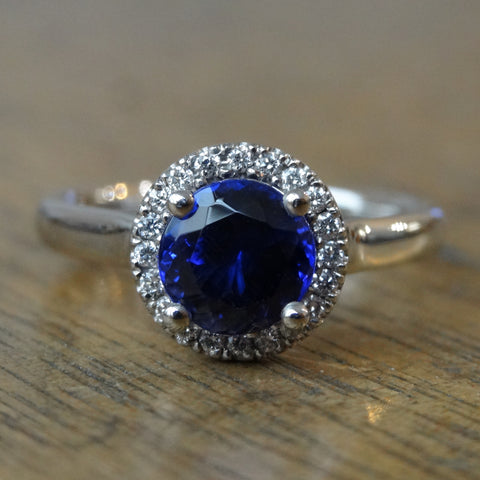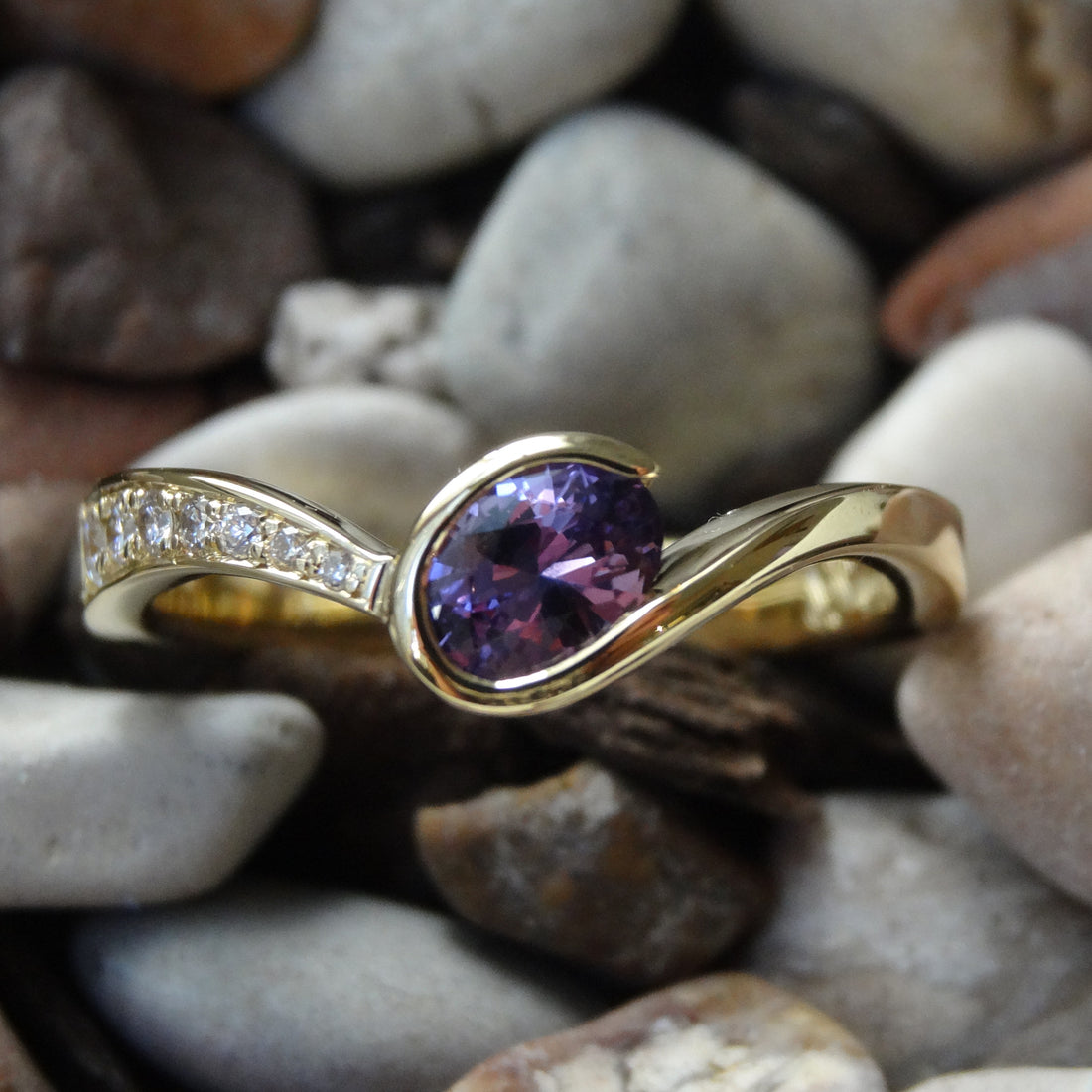Buying an engagement ring alone or together with your partner, hands down- it's a daunting process. There is so much to know and many things to consider, especially if you're thinking about a bespoke creation. Never-mind the added stress of choosing something today that not only symbolises your love and the future you’re building together but to choose something that is unique as well as ‘stand the test of time’. It's a tough task to say the least. But never to fear though, we are here to help you. So please, read on...
How much does an engagement ring cost?
This is a tricky question, the answer is practically 'how long is a piece of string'? There are sooooo many alternatives and cost variances that it's impossible to have an answer to this. After many years working with clients I've found it works best if you turn it around and consider 'what can I afford?', or 'what do I want to spend on an engagement ring?'.
You may have heard the old tale of the '3 months salary' or the alike. I’m not here to speak for anyone per say but this is really some hallmark hearsay made up by large jewellery manufactures or diamond merchants. Whilst anything 'bespoke' does carry a higher price-tag compared to an item that is ready-made, it might not be as much as you think. You can read our bespoke engagement ring starting price-guide here.
We recommend you spend what you can afford or what you feel comfortable with. Often the easiest thing is to get in touch, let us know your budget and your ideas and we can work back from there and let you know what is possible.
What does an engagement ring look like?
Whilst not limited to, typically an engagement ring has a larger central stone and is sometimes accompanied by smaller diamonds or gemstones set in precious metals like gold or platinum and is worn on the ring finger.
Historically, (I’m talking only about the last couple of decades) the majority of engagement rings purchased were one of 3 styles and all of which are deemed a ‘classic’ design today. In a nutshell these designs are:
-
A ‘solitaire’ (single stone ring)

- A ‘trilogy’ (three stone ring) can be any combination of stone types and/or shapes.

- And finally, a ‘halo’ (small diamonds or gemstones set around a larger centre stone).

What if you have no idea what kind of engagement ring you're shopping for?
If you are quite literally a blank canvas, meaning you have no idea whatsoever what you or your partner would like in a ring we suggest you start with answering these questions:
- Do you know if you would like a diamond or a coloured stone?
- Do you prefer simple or complex or intricate jewellery designs?
- Would you like the ring to be symmetrical or asymmetrical?
- Is there a concept or idea you want to include in the design? i.e. floral patterns, art-deco, modern or perhaps some engraving.
We also like to find out a bit more about the wearer too, as personalities often align with styles and types of jewellery.
- What kind of jewellery is worn by the recipient?
- Is the person an adventurer or a quiet soul?
- Do they appreciate fine art and sculpture or maybe pop-art or comics? There may be some things here to draw inspiration from.
Getting the surrounding facts helps us paint a picture of the wearer and are better able to suggest ideas too.
What if you want a unique engagement ring?
With the strengthening of our own personal identities in recent years and the increased desire to celebrate the uniqueness we all have, we are seeing so much diversity in the engagement ring market today. Which is a real treat for bench designers and jewellers like us. Let us tell you now though, being unique doesn’t mean you have to have a loud and cumbersome ring, there are so many ways we can tailor a design to suit you and your partner. Many of these ideas can come from answering the above questions. We are buzzing with ideas and love sharing them with you, so please let us know if this is a concept you'd like to hone in on.
* Get Some Inspiration From Our Gallery *
What type of stones are best suited in engagement rings?
When considering stones for an engagement ring, we recommend 3 different types. This is purely based on the stones hardness and durability. What does this mean to you? Essentially is its ability to withstand the test of time. These days, an engagement ring is worn everyday and the materials used have to reflect this. More than ever, we are really active and busy people compared to that of a stay home parent of the 1930’s who only wore their ring to the shops and parties. Needless to say, rings of yesteryear were not subjected to the gruelling busy life like the ones of today. Thus the three stone varieties that can survive a battering are:
- Diamond (natural & lab grown). Pictured left to right:
tinted, fancy light yellow, champagne, cognac, blue, green, near colourless
- Corundum (which is sapphire & ruby) and can be either natural or lab grown, some colours will vary. Pictured left to right:
white, light peach, yellow, rose, pink, red, yellow parti, light green, mid green, real, dark blue and mid blue.
- Moissanite. Pictured: White moissanites. Colours are available, please ask us about more options.

If a pop of colour is on your design list, we have you covered because within the three recommended stones above, just about every colour is represented.
Softer stones such as topaz, citrine, and those from the beryl family - aquamarine & emerald will scratch and visually degrade over time (faster than the above). Whilst its not impossible to have a stone of the aforementioned, you will have to be extremely careful and expect to have the stone scuff or chip or worse, need replacing in 5-15 years.
It's also worth noting, that while diamonds are the hardest material known to man they are not indestructible. Diamonds can still chip and break under duress especially if their natural inclusions create a weakness in the stone, however they are ultimately the more durable and longest lasting stone and the best option for an engagement ring.
- Want to know more about the different stone options available with us?
Read our sustainable jewellery page - Want to see a selection of our loose diamonds?
Browse our diamond collection - Want to see a selection of our loose gemstones?
Browse our gemstone collection
What Metal Should I Choose for an Engagement Ring?
For some, this is a no brainer as they know what colour or type of metal is preferred. This may be because the wearer only likes rose gold or can only wear yellow gold because of sensitive skin. For those who are not sure we will break it down into small digestible bites,
Most commonly today, engagement rings are made from gold (either 18ct or 14ct in three colours - yellow, rose & white) or platinum. Less common is palladium due to its exponential cost increase in recent years and silver because its too soft. Each metal has its pros and cons and some excel in certain situations over others.
GOLD
There are 3 common carats of gold used to make jewellery. To best understand this, 24ct is pure (100%) gold and when pure gold is alloyed down (to make it harder as pure gold is too soft) it is then referred to as
- 18ct - 75% pure gold & 25% alloy
- 14ct - 58.5% pure gold & 41.5% alloy
- 9ct - 37.5% pure gold & 62.5% alloy
The act of alloying down 24ct gold is twofold, on the one hand it hardens the metal so it can be used to hold gems securely and not dent or wear away as quickly as 24ct gold would - which is extremely soft and malleable. Just adding 25% of alloy to 24ct to make it 18ct increases its durability drastically.
There are many discussions about whether 9ct is harder than 18ct because of the alloy content; however it's not as simple as that. Hardness and durability are different. In essence 18ct and 14ct golds offer the best all-round characteristics and they are still a high content of gold (durable) which also means the rings won’t tarnish comparatively to 9ct where 62.5% is silver and copper alloy.
Furthermore, bridal jewellery is traditionally made from higher carat metals such as 18ct for it’s extra gold content which in-turn is considered a better 'investment' considering the investments and the stability of gold.
CONCLUSION:
For all of the above reasons we recommend 18ct & 14ct (in any colour) for everyday jewellery. 9ct is often too soft for fine engagement rings so in this scenario its not the best option. The colour is really up to you, so this is something that can be used to personalise your engagement ring.
PLATINUM
Platinum is a naturally occurring white and very dense metal and requires a further refined skill set to work with, making it a luxurious and elite metal choice. The denseness of platinum makes it extremely hard wearing especially when it comes to holding diamonds and gemstones so it's perfect for engagement rings. Quite often it is compared to white gold in the following areas:
- Colour
Comparatively platinum is whiter and brighter to white gold. This is because white gold is derived from pure (yellow) gold and the alloys used in this make it a grey colour. This has lead to the common practice of rhodium plating white gold to make it the same white/bright colour as platinum. Rhodium plating is a process whereby white gold it is electroplated with a very fine layer of a pure, white metal, called rhodium. This masks the surface and creates the appearance of a brighter white, closer to that of platinum. To maintain this finish re-plating is usually needed every 12-24 months. Unfortunately, Rhodium mining and extraction techniques have a detrimental effect on the environment, as do the harmful chemicals used in the electroplating process. So we have made the conscious decision not to plate any of our White Gold jewellery unless requested. So our jewellery has a distinct colour different when comparing platinum to white gold. More often than not our clients prefer the natural colour of white gold, its a much warner colour that accompanies a lot of coloured stones. All of our 14K and 18K White Golds are alloyed with Palladium, the whitest alloys available that do not contain nickel. - Longevity
Because of the metals density, it takes longer to wear away compared to 14ct or 18ct gold. However, platinum is quite malleable and will dent and scratch more than other metals but it won't wear down as fast. - Best application
For the reasons listed above, platinum is best when a whiter metal is preferred over a greyer and warmer (white gold) alternative. Its also best used for rings that have finer claws or delicate decorative elements. However 18ct white gold is a better choice when you have engraving and milgrain as it will hold firm on these pattern elements better.
CONCLUSION:
A superior white metal that is long lasting, the downside is it comes at a higher cost to other options and is not ideal for all ring designs.
Contact us through the form at the bottom if the page if you have a specific request and we can advise you on what is best.
SILVER
Lastly, although not impossible - we do not recommend having an engagement ring made from sterling silver. Silver is extremely soft and lightweight so it does not possess the same rigid and reliable strength properties of gold and platinum. Which again, is critical when holding expensive gems.
CONCLUSION:
Not recommended as its not suitable in most engagement ring scenarios.
Wait, I've got more questions!
We hope this article has been helpful but if we've not answered all your questions or you're ready to talk to an expert, please fill in the contact form below and we can begin your bespoke engagement ring journey today.
Warmest Regards,
Jenna & Megan.

